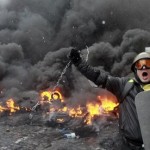The news from Ukraine is frightening and familiar.
At least 100 people have been killed in rioting in Kiev. Some were shot by Interior Ministry snipers after demanding that President Viktor Yanukovych allow new elections. The latest is that he may do just that.
Like all former Soviet republics, Ukraine has been caught in the usual post-collapse of the U.S.S.R. Liberal Democrats can’t amass enough power to overturn leftovers from the Communist system who have prisons and police at their disposal.
The economy has not recovered from the shock of the Soviet split up. It happened too fast. You can’t go from a seriously ossified command structure that provided cradle-to-grave services, crash it and then pretend the “magic of the market” will work overnight, or even in 25 years.
These failures have set up the tragedy in Kiev that if not controlled soon, could get truly scary. All Europe needs right now is a civil war on its edge. So far, the Ukrainian military is not involved and luckily for the world, Ukraine apparently got rid of its 5,000 nuclear weapons after the Soviet Union broke apart in 1991.
For me personally, the Kiev drama is reminiscent on several levels. I used to go to Kiev and Ukraine fairly often. Downtown Kiev is lovely. The main drag where the violence is taking place is on Khristyatyk Street, an impressive boulevard of monuments and buildings. I used to stay at a hotel around the corner near a leafy park on a bluff overlooking the Dnieper River.
Ukrainians are pleasant and friendly – somewhat like U.S. Midwesterners or Southerners. Ukraine used to be a farming dynamo until Stalin got involved. It also has some impressive industries, including advanced metallurgy and an aircraft plant that makes gigantic Antonov cargo planes. Tragically, it was also the scene of Chernobyl.
There’s been an underlying tension between western Ukrainians who felt much more in common with Western Europe and the east where Russians and their language prevailed. The friction, however, never got as intense as between Russians and, say, the Chechens or Central Asians. Ukrainians are very close in religion, language and color. There were rivalries and insults, such as Russians who dubbed Ukrainians “Hok-lee” which is a putdown of the Ukrainian language which is very close to Russian but has different inflections. Some Ukrainians hate being called “the” Ukraine because it means “on the edge” of Russia.
Vladimir Putin is a major player in today’s problems. Just as Ukraine was getting closer to the European Union in aid, trade and funding, Putin swept in with a $15 billion aid package. Putin is part of the old “Sil” or “forces” such as the KGB who have re-emerged in a new form, sort of like the robo-cop in the Terminator II movie.
The scenes from Kiev are also extremely reminiscent of what happened in Russia in 1991 and 1991. In the former, the “sil” came after Mikhail Gorbachev. In 1993, Boris Yeltsin disbanded the old-style Communist era Parliament, resulting in open warfare involving machine guns, T-80 tanks and armored personnel carriers. Personal note: I edited coverage in New York in 1991 and in 1993, I was on the streets of Moscow and don’t remember ever being so scared for my safety.
In both countries, you have highly-capable elites of intellectuals but there is no strong and developed middle class to support them. That allows thugs to fill the power void, making the nation vulnerable to Putin who obviously doesn’t want liberalization that can become a yardstick for Russia’s lack of similar progress.
Personally, I blame some Western meddlers for a lot of the problems. When the Soviet empire fell apart at warp speed in the 1990s, economists from Harvard and the International Monetary Fund swept in with “shock” therapy ideas for the economy. It was pretty much the standard fare that you hear today from the tight money people regarding the American recession. Instead of feeding the patient, you starve him. Cut government spending and let market forces prevail.
Well that didn’t happen. The system involved having state-owned factories and farms provide everything from nurseries to schools to vacation dachas to funeral parlors. For example, when I lived in Moscow and my older daughter was ready for kindergarten, we put her in one that had been set up by a factory that had made pencils.
In theory, classic capitalism should have saved the day. But the crash privatization and loans for shares programs failed miserably. Grandmothers suddenly found themselves getting stock certificates for enterprises. They had no idea what to do with them, allowing a savvy and greedy group of oligarchs to swoop in and pick them up. A far-sighted plan for a very gradual transition from socialism to capitalism or some form of mixed economy was what as needed, not crash theories.
At the time, I kept wondering why the power forces didn’t take over. Where were they? Well, they did, about 15 years ago. What’s going on in downtown Kiev, coupled with the failure of sensible economic policies, is the result.



